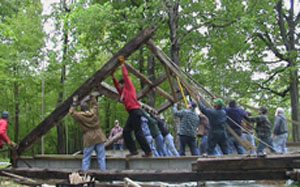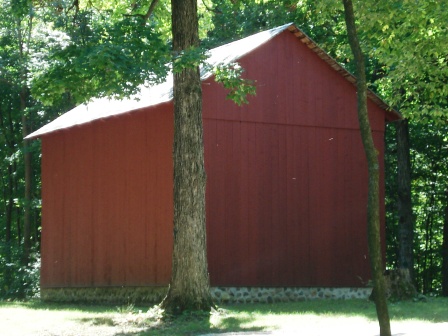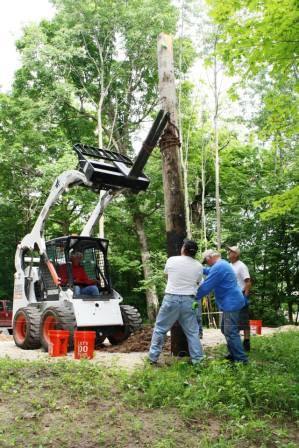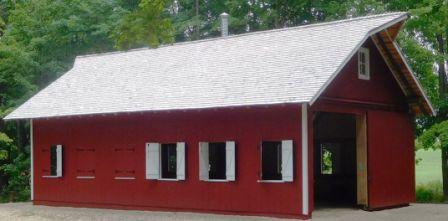Timber Frame Area
The granary and maple sugar shack are located on the south end of the Richfield Historical Park. Both of these structures are great examples of timber frame construction. A blacksmith shop has been designed and the construction has started.
Granary
The granary was originally located near Kewaskum and was built in
the late 1800s or early 1900. In 2001, the owner offered it to the
Richfield Historical Society, and a crew of volunteers dismantled it.  The
reconstruction work started in 2003 with the help of Lyle Lindholm, an
expert in timber framing. Each piece of the framework (called a bent)
was constructed on the floor. The old-fashioned 'barn raising' took
place on
The
reconstruction work started in 2003 with the help of Lyle Lindholm, an
expert in timber framing. Each piece of the framework (called a bent)
was constructed on the floor. The old-fashioned 'barn raising' took
place on  May 31, 2003. This event consisted of several people manning 'bent
poles' to push up the 'bents'. A lean-to was added in 2012 to provide
additional storage.
May 31, 2003. This event consisted of several people manning 'bent
poles' to push up the 'bents'. A lean-to was added in 2012 to provide
additional storage.
Currently, the granary is used for storage of many artifacts.
Sugar Shack
Oh, so many maple trees in the Richfield Historical Park but no way
to collect the sap to make into sweet maple syrup. Problem solved! A
 member, Ed Boldt, donated his maple syrup making equipment and sap has
been collected ever since. For 2
years, the maple syrup team boiled the sap outdoors in all kinds of
spring weather--snow, rain, freezing temperatures. Then, in 2005 a member's son was
member, Ed Boldt, donated his maple syrup making equipment and sap has
been collected ever since. For 2
years, the maple syrup team boiled the sap outdoors in all kinds of
spring weather--snow, rain, freezing temperatures. Then, in 2005 a member's son was working toward his Eagle Scout
status and needed a project. Darin Dumke designed and built the maple
sugar shack. How different making maple syrup is now. The team works
inside, boiling the sap in the old-fashioned way using a wood burning
sap evaporator pan. Every spring, families come to the Park to enjoy
Maple Syrup Family Day, one of several RHS Events.
working toward his Eagle Scout
status and needed a project. Darin Dumke designed and built the maple
sugar shack. How different making maple syrup is now. The team works
inside, boiling the sap in the old-fashioned way using a wood burning
sap evaporator pan. Every spring, families come to the Park to enjoy
Maple Syrup Family Day, one of several RHS Events.
Blacksmith Shop
The blacksmith shop located right across from the Sugar Shack in the Richfield Historical Park was completed in 2017. Once the grading was done for this project, it was determined that extra fill was needed. When the parking lot was developed by the Lillicrapp Welcome Center, soil was dug up and hauled to the blacksmith shop area -- a perfect solution.
With a lot of electrical work being done in the Richfield area,  the electric company donated some of the poles that are being replaced. These strong poles are now the main support of this building.
the electric company donated some of the poles that are being replaced. These strong poles are now the main support of this building.
The next step with this project was the  installation of the girts. These are the pieces to which the siding was eventually fastened. Rafters were put in place. The rafters were upcycled from an old barn that was dismantled in Richfield. Cedar shingles covered the rafters.
installation of the girts. These are the pieces to which the siding was eventually fastened. Rafters were put in place. The rafters were upcycled from an old barn that was dismantled in Richfield. Cedar shingles covered the rafters.
 With the siding completed and painted as well as the shutters and doors installed, the blacksmith shop was finished. The forge was buil
With the siding completed and painted as well as the shutters and doors installed, the blacksmith shop was finished. The forge was buil t, bellows were installed and other additional equipment added. The last piece was the outside sign.
t, bellows were installed and other additional equipment added. The last piece was the outside sign.
Some very generous donations were received for the construction of this building. If you would like to have a horseshoe hanging in the shop with a customized inscription on a brass plate, just fill out the Horsehoe Form and donate $100 or more. Your donation will help with operating costs and continued improvements to the building.
The blacksmith shop is a great enhancement to the Park. During RHS events, visitors are able to see demonstrations of the skills of blacksmithing -- forging (sometimes called "sculpting"), welding, heat-treating, and finishing. The village blacksmith was a craftsman who was essential to pioneer life. Every crossroads village had a blacksmith shop to create and repair farm equipment, make household utensils, tools, wagon wheels, parts of oxen yokes, and much more.

